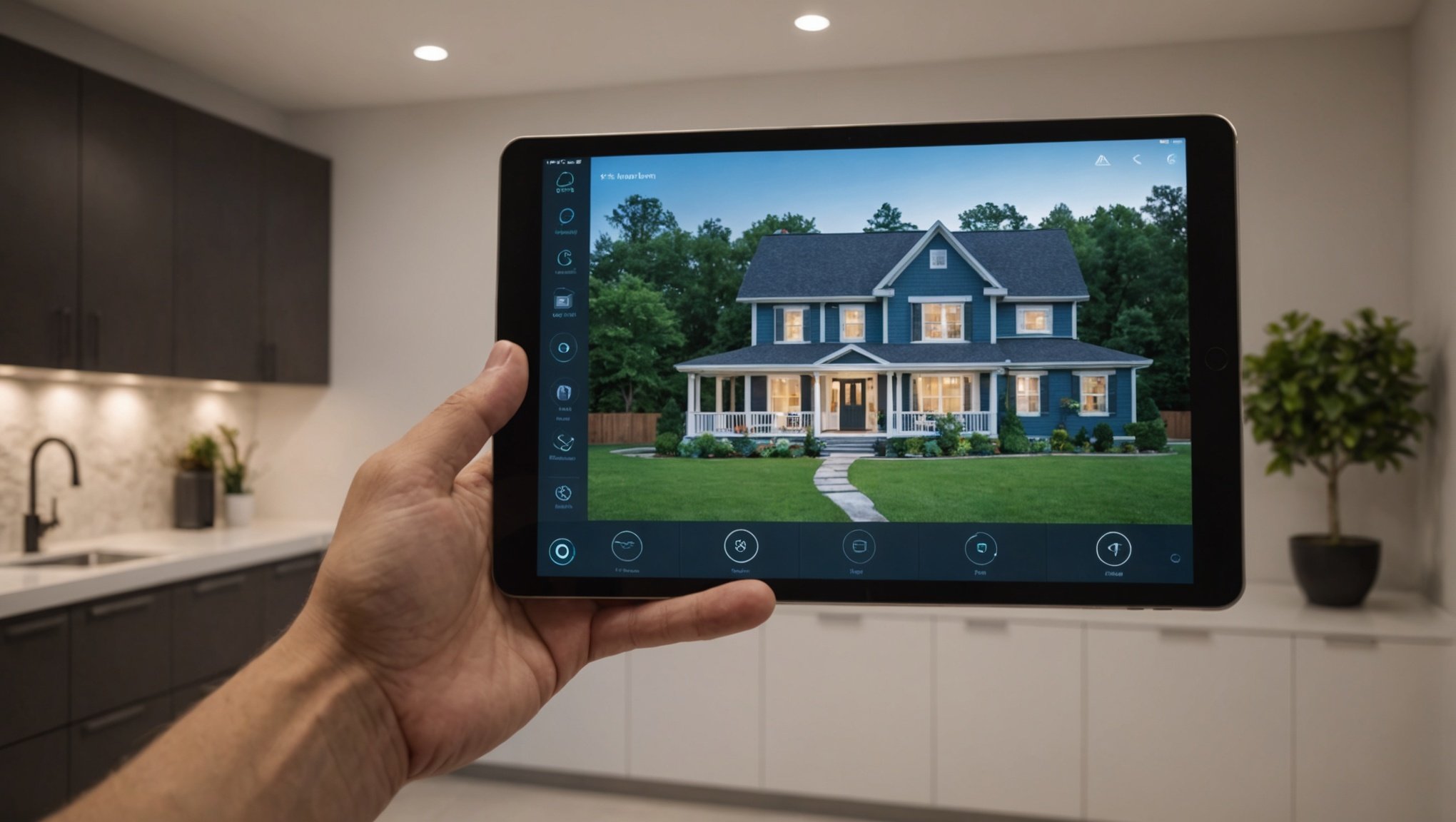Revolutionizing Smart Home Automation: The Role of AI in Transforming User Experience
In the era of smart homes, the integration of artificial intelligence (AI) is revolutionizing the way we live, interact, and manage our living spaces. AI is not just an add-on to smart home technology; it is the backbone that makes these homes truly intelligent, responsive, and personalized. Here’s a deep dive into how AI is transforming the smart home experience.
Where AI Excels in Smart Home Applications
AI in smart homes excels in areas that often go unnoticed by the end users but significantly enhance their experience. One of the key features of AI-powered smart homes is the ability to configure advanced systems and personalize automations with ease.
Additional reading : Mastering AI: Crafting a Robust Network for Essential Infrastructure Resilience
For instance, platforms like Josh.ai allow homeowners to create automations simply by telling the system what they want to happen using natural language. This is similar to how you might ask ChatGPT or Google’s Gemini to summarize complex topics concisely. Complex automations can be created without the need for intricate programming, making the process user-friendly and intuitive.
AI also plays a crucial role behind the scenes by monitoring systems, flagging alerts when devices need attention, and ensuring home security. For example, Crestron’s Solar Sync feature reads the color temperature of the sun, factors in the time of day, and adjusts lighting systems accordingly. This level of automation not only enhances convenience but also optimizes energy usage and creates a more comfortable living environment.
Additional reading : Revolutionizing Online Identity Verification: The Role of Blockchain Technology in Streamlining Processes
How AI Learns and Adapts to User Habits
One of the most impressive aspects of AI in smart homes is its ability to learn and adapt to user habits. AI-powered smart switches, like those described by BriteHome, observe daily routines, learn from them, and anticipate actions based on user preferences.
Imagine walking into your living room after a long day, and the room lights up to your preferred brightness, with your favorite ambient settings automatically adjusted to relax you. This level of personalization is achieved through AI-driven learning algorithms that analyze your daily interactions with smart devices. For example, if you consistently dim the lights at 7 PM for a relaxing evening, the AI will automatically adjust to that setting without any manual input.
Seamless Integration with Your Daily Life
AI-powered smart home devices integrate seamlessly with the entire ecosystem of smart devices in your home. This integration goes beyond just lighting control; it includes adjusting the temperature, closing the blinds, and managing security features like motion detectors and cameras.
Here’s an example of how this works:
- Morning Routine: As you wake up, the AI softly illuminates the room, raises the blinds, and sets the coffee maker to brew—all based on your established routines.
- Energy Efficiency: By learning your usage patterns, the smart switch can turn off lights and devices when they’re not needed, optimizing energy consumption without compromising on comfort.
- Proactive Maintenance: The AI can detect irregular patterns or potential issues in your smart home system, such as a faulty light or an unresponsive device, and notify you in real-time.
Core Features of AI-Driven Smart Home Automation
AI-driven smart home automation offers several core features that enhance the user experience significantly.
Personalized Automation
AI algorithms analyze user habits to automate tasks such as adjusting lighting, temperature, and security settings based on time of day or occupancy. For instance, an AI-driven home automation system can learn your routines and adjust the lighting and temperature accordingly, ensuring a comfortable and energy-efficient environment.
Energy Management
Smart home systems can monitor energy usage and suggest optimizations, such as scheduling appliances to run during off-peak hours, thereby reducing costs. This not only helps homeowners save money but also contributes to a more sustainable living environment.
Voice Control and Interaction
Devices like smart speakers serve as central hubs, allowing users to control various IoT devices through voice commands. This capability, seen prominently in voice control systems powered by Google Home, Alexa, and Apple’s Siri, makes the experience seamless and intuitive.
Enhanced Security and User Experience
AI in smart homes also significantly enhances security and the overall user experience.
Enhanced Security
AI can analyze data from security cameras and sensors to detect unusual activities, sending alerts to homeowners in real-time. For example, autonomous agents integrated with Google AI can access a wealth of information, providing more contextual awareness and better security management.
Improved User Experience
By learning from user interactions, AI can provide tailored recommendations, such as suggesting the best time to water plants based on weather forecasts. This level of personalization makes the home more responsive and comfortable.
Here are some benefits of AI in smart home automation:
- Personalized Recommendations: AI suggests playlists based on your workout schedule or mood, and recommends apps that align with your daily activities.
- Scalability: As more devices are added to a smart home ecosystem, AI manages and optimizes interactions between them, ensuring a cohesive experience.
- Efficiency Meets Energy Savings: AI optimizes energy consumption by turning off lights and devices when not needed, contributing to lower electricity bills and a reduced carbon footprint.
The Future of Autonomous Agents in Home Automation
The future of autonomous agents in home automation is promising, with several exciting possibilities on the horizon.
AIoT and Advanced Integrations
Concepts like AIoT (Artificial Intelligence of Things) involve leveraging data from various devices to create an individualized AI stack. This AI stack can infer intelligence from the data, offering personalized insights to enhance daily life. For example, a smart home system could monitor sleep patterns, lighting preferences, and other behaviors to optimize the living environment continuously.
Large Language Models and Predictive Analytics
Large language models (LLMs) are becoming adept at understanding context and nuance, enabling autonomous agents to handle complex tasks. Imagine an AI assistant that not only controls your smart thermostat but also analyzes your energy usage patterns, local weather forecasts, and daily routines to optimize comfort and efficiency in unprecedented ways.
Technical Considerations and Challenges
While AI is revolutionizing smart home automation, there are several technical considerations and challenges that need to be addressed.
Robust Infrastructure
Implementing AI for personalized experiences requires a scalable system capable of handling large volumes of data and complex algorithms. This includes ensuring robust infrastructure that can support the integration of various IoT devices and AI models.
Privacy Measures
Ensuring user data is handled securely and transparently is crucial. Companies must exercise caution when developing AI systems, balancing AI’s capabilities with the responsibility to protect user data. This involves implementing robust privacy measures and maintaining transparency in data handling practices.
Practical Applications and Examples
Here are some practical applications and examples of how AI is transforming smart home automation:
Smart Home Automation
- Learns Routines: Adjusts lighting and temperature based on the time of day and user presence.
- Optimizes Energy Usage: Analyzes energy consumption patterns to suggest optimal usage times, potentially saving costs.
- Seamless Integration: Integrates with your home’s entire ecosystem of smart devices, managing tasks such as adjusting the temperature, closing the blinds, and managing security features.
Personalized Recommendations
- Music Playlists: Suggests playlists based on your workout schedule or mood.
- App Suggestions: Recommends apps that align with your daily activities, such as productivity tools during work hours.
- Home Maintenance: Detects irregular patterns or potential issues in your smart home system and notifies you in real-time.
Table: Comparing Key Features of AI-Powered Smart Home Systems
| Feature | Description | Example |
|---|---|---|
| Personalized Automation | Automates tasks based on user habits and preferences. | Adjusts lighting and temperature based on time of day and occupancy. |
| Energy Management | Monitors and optimizes energy usage. | Schedules appliances to run during off-peak hours. |
| Voice Control | Allows control of IoT devices through voice commands. | Uses Google Home, Alexa, or Apple’s Siri for voice control. |
| Enhanced Security | Analyzes data to detect unusual activities and sends real-time alerts. | Uses security cameras and sensors to detect unusual activities. |
| Seamless Integration | Integrates with various smart devices to manage tasks. | Manages tasks such as adjusting temperature, closing blinds, and security features. |
| Proactive Maintenance | Detects irregular patterns and notifies users in real-time. | Notifies users of faulty lights or unresponsive devices. |
| Energy Efficiency | Optimizes energy consumption based on user habits. | Turns off lights and devices when not needed to save energy. |
Quotes from Industry Experts
- “The core foundation of that is you have to have the data to start,” emphasizes Hintze from Crestron, pointing to the potential of AIoT to revolutionize how we interact with our homes.
- “AI models in the home should tread lightly, and at first, simply offer suggestions based on what it thinks the user wants to do,” says Capacelatro, highlighting the importance of balancing AI’s capabilities with user comfort.
- “These integrations create a more efficient, responsive home environment. By leveraging existing APIs and data sources, autonomous agents can communicate with a wide range of devices and systems,” notes the team at SmythOS, emphasizing the seamless integration of AI in smart homes.
Real-World Examples and Anecdotes
Imagine a scenario where you’re heading home after a long day. Your autonomous agent, powered by AI, turns on the lights, sets the perfect temperature, and starts your favorite playlist—all before you even walk through the door. This is not just a fantasy; it’s the reality of living in an AI-powered smart home.
For instance, Chris Hall from Savant describes how their Apple-based automation taps into Apple’s M series chips and powerful AI APIs, allowing for advanced security features and AI-based object detection. This level of integration makes the smart home experience not just convenient but also highly secure and personalized.
Practical Insights and Actionable Advice
If you’re considering integrating AI into your smart home, here are some practical insights and actionable advice:
- Start Small: Begin with basic smart devices and gradually integrate more complex AI-powered systems.
- Choose Compatible Devices: Ensure that all your smart devices are compatible with each other to avoid integration issues.
- Focus on Energy Efficiency: Use AI to optimize energy consumption by automating tasks such as turning off lights and devices when not needed.
- Prioritize Security: Implement robust security measures to protect user data and ensure the security of your smart home system.
- Regular Updates: Keep your AI-powered smart home devices updated with the latest software to ensure they remain efficient and secure.
In conclusion, the integration of AI in smart home automation is transforming the way we live and interact with our homes. From personalized automations and energy management to enhanced security and seamless integration, AI is making smart homes smarter, more efficient, and more comfortable. As technology continues to evolve, we can expect even more innovative and intuitive interactions between our homes and the AI agents that help manage them.











